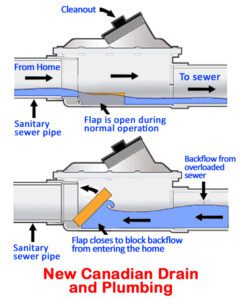The Difference Between a Backwater Valve and a Backflow Preventer
Backwater Valve Installation in Toronto, and the GTA – Contact us today at (416) 651-2990

When you’ve been in the plumbing industry for as long as we have, you see your fair share of DIY plumbing nightmares. Many people mean well and are just trying to save a few bucks by taking on the job themselves, but without the proper knowledge it’s possible (and with certain types of plumbing work very likely) that you could do more harm than good. A better option is to let a trained professional tackle the job and be sure that it will be done right the first time.
New Canadian Drain & Plumbing has been serving the plumbing needs of commercial and residential clients throughout the Toronto area for years now and are specialists when it comes to anything drain-related — drain cleaning, drain repairs and drain replacements. One thing we get asked about fairly often is backflow preventers. The problem is, some people confuse backflow preventers with backwater valves as the two terms have become relatively interchangeable among homeowners in recent years. As any Toronto plumbing professional will tell you though, a backflow preventer performs a different function to a backwater valve. During this article we are going to talk about each one and make the differences clear.
Backwater Valves — What Are They?
If you know someone who had their basement flooded as a result of the storms earlier in the year and have been thinking you should really do something to protect your own, it’s a backwater valve that you need to have installed. A backwater valve is a special type of valve that is installed on your sewage line, at the point where it leaves your property and connects to the public sewage line. When a basement floods during a storm it is usually because more water has entered the public sewers through street drains than the system is able to handle, and rather than making its way to the treatment plant like usual, it backs up towards your home and exits through the drains in your basement. A backwater valve prevents this water from getting into your property’s system by detecting when backflow conditions arise and sealing off the pipe. In other words, it will only let water flow out of your system, not in.
Backflow Preventers — What Are They?
Rather than preventing sewage waste from backing up and flooding your home, a backflow preventer is designed to protect your water supply. Under certain conditions it’s possible that the flow of water through your water line may reverse and non-potable water and other contaminants may be allowed to flow back into the main. Should this happen, you and your neighbours could unknowingly consume contaminated water, which is obviously a serious health hazard. Much like a backwater valve, a backflow preventer will only allow water to flow in a single direction. But unlike a backwater valve, its aim is to prevent the water from leaving your system rather than entering it.
What Exactly is Backflow and How Does It Occur?
Both of these devices are designed to prevent backflow (although in different directions as just mentioned), which is when water flows through a system in the opposite direction that it is intended to. With regards to the your sewage line, there are two main reasons that backflow can occur:
1) A major storm such as the one experienced in the Greater Toronto Area on July 8th, 2013. Toronto’s sewers are simply not designed to deal with a sudden increase in water.
2) A blockage in the system can also cause backflow, as the water is left with nowhere to go other than to back up towards your property.
The backflow that backflow preventers deal with is caused by different factors though, and contamination of public water supply is always a risk if you have cross connections in your water system. By that we mean anything which uses a non-potable water supply or chemicals and is hooked up to your home’s potable water supply. This could be anything from an air-conditioning unit to a sprinkler system containing chemicals for the plants in your garden. There are two main types of backflow that can arise:
- Back-siphonage, which is when a water inlet in your home is fully submerged and the pressure balance between the public main and your home’s water system reverses. This results in the substance which is submerging the inlet being sucked up and back into the public water supply.
- Back-pressure, which is when the pressure in your system builds and exceeds that of the public main, reversing the flow of water. This can sometimes occur if you have a new appliance installed (like a new boiler or garden pump) or the public main becomes damaged and loses pressure.
New Canadian Drain & Plumbing are capable of installing backwater valves inside or outside your home and would be glad to talk to you in greater detail about the benefits that each device provides, how they function and the estimated cost of installation.


